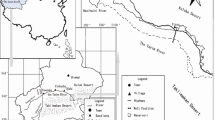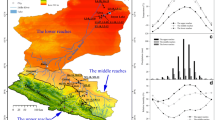Abstract
The water table in the Three Gorges Reservoir (TGR) rose significantly since the construction of the Three Gorges Dam across the Yangtze River. Little is known about how such a change in local hydrological condition will affect the ecophysiology of plants along the bank of the world’s largest reservoir. In this study, water relations of the dominant plants were investigated over an entire year period by comparing stable isotope compositions of xylem water, leaf water potentials and foliar carbon isotope ratios at a newly-formed riparian site near the river bank and two non-riparian sites at higher elevations. The isotopic compositions of xylem water indicated that the plants in the newly-formed riparian zone acquired water mainly from the soil previously infiltrated by local rain rather than the Yangtze River water. Predawn and midday water potentials of the riparian trees were also similar to those at the non-riparian sites. Leaf δ13C values of plants across the three sites also showed no difference, even though there was a significant difference among species. Our results indicate that plants at the newly formed transient riparian area along the bank of TGR do not depend on the Yangtze River water for their water sources and that rising water levels in this reservoir may not lead to immediate changes in water relations of the plants along the bank.






Similar content being viewed by others
References
Alberts HC, Alberts RM, Bloom MF, LaFlamme AD, Teerikangas S (2004) The Three Gorges Dam Project from a systems viewpoint. Syst Res Behav Sci 21:585–602
Cernusak LA, Aranda J, Marshall JD, Winter K (2007) Large variation in whole-plant water-use efficiency among tropical tree species. New Phytol 173:294–305
Chen WL, Zhang XQ, Liang SY, Jin YX, Yang QX (1994) Plants and composite agricultural ecosystems of the Three Gorges Reservoir Region. Science Press, Beijing
Cheng RM, Xiao WF, Li JW, Ma J, Han JJ (2002) Analysis on forest plant diversity in the Three Gorges Reservoir Area. Chinese J Appl Ecol 13:35–40
Craig H (1961) Isotopic variations in meteoric waters. Science 133:7747–7751
Damesin C, Rambal S, Joffre R (1998) Seasonal and annual changes in leaf δ13C in two co-occurring Mediterranean oaks: relations to leaf growth and drought progression. Funct Ecol 12:778–785
Dawson TE, Ehleringer JR (1991) Streamside trees that do not use stream water. Nature 350:335–337
Dawson TE, Mambelli S, Plamboeck AH, Templer PH, Tu KP (2002) Stable isotopes in plant ecology. Annu Rev Ecol Syst 33:507–559
Deng H, Wang Q (2001) Water and nutrient circulations in complex ecosystem of small catchment in the Three-Gorge Region. Resour Environ Yangtze Basin 10:432–439
Drake PL, Franks PJ (2003) Water resource partitioning, stem xylem hydraulic properties, and plant water use strategies in a seasonally dry riparian tropical rainforest. Oecologia 137:321–329
Farquhar GD, Ehleringer JR, Hubick KT (1989) Carbon isotope discrimination and photosynthesis. Annu Rev Plant Physiol 40:503–537
Graf WL (1999) Dam nation: a geographic census of American dams and their large-scale hydrologic impacts. Water Resour Res 35:1305–1311
Huang ZL (2001) Biodiversity conservation for the Three Gorges Project. Biodivers Sci 9:472–481
Kolb TE, Hart SC, Amundson R (1997) Boxelder water sources and physiology at perennial and ephemeral stream sites in Arizona. Tree Physiol 17:151–160
Liu H, Liu HJ, Qu JH (2004) Effect of nitrogen and phosphorus on the water quality in the Three Gorges Reservoir Area during and after its construction. J Environ Sci (China) 16:358–363
Mensforth LJ, Thorburn PJ, Tyerman SD, Walker GR (1994) Sources of water used by riparian Eucalyptus camaldulensis overlying highly saline groundwater. Oecologia 100:21–28
Miller N, Jin JM, He H, Tsang CF (2005) Local climate sensitivity to the Three Gorges Dam. Bull Am Meteorol Soc 86:334–335
O’Leary MH (1981) Carbon isotope fractionation in plants. Phytochemistry 20:553–567
Ryel R, Leffler A, Peek M, Ivans C, Caldwell M (2004) Water conservation in Artemisia tridentata through redistribution of precipitation. Oecologia 141:335–345
Sellin A (1996) Base water potential of Picea abies as a charateristic of the soil water status. Plant Soil 184:273–280
Shen GZ, Xie ZQ (2004) Three Gorges Project: chance and challenge. Science 304:681–681
Smith SD, Wellington AB, Nachlinger JL, Fox CA (1991) Functional-Responses of riparian vegetation to streamflow diversion in the Eastern Sierra-Nevada. Ecol Appl 1:89–97
Snyder KA, Williams DG (2000) Water sources used by riparian trees varies among stream types on the San Pedro River, Arizona. Agric For Meteorol 105:227–240
Terwilliger VJ, Kitajima K, Le Roux-Swarthout DJ, Mulkey S, Wright SJ (2001) Intrinsic water-use efficiency and heterotrophic investment in tropical leaf growth of two Neotropical pioneer tree species as estimated from delta C–13 values. New Phytol 152:267–281
Thorburn PJ, Walker GR (1993) The source of water transpired by Eucalyptus camaldulensis: soil, groundwater, or stream? In: Ehleringer JR, Hall AE, Farquhar GD (eds) Stable isotopes and plant carbon–water relations. Academic Press, Inc., San Diego, pp 511–527
Tyree MT, Ewers FW (1991) The hydraulic architecture of trees and other woody plants. New Phytol 119:345–360
Tyree MT, Ewers FW (1996) Hydraulic architecture of woody tropical plants. In: Mulkey SS, Chazdon RL, Smith AP (eds) Tropical forest ecophysiology. Chapman & Hall, New York, pp 217–243
White JWC, Cook ER, Lawrence JR, Broecker WS (1985) The deuterium to hydrogen ratios of sap in trees: implications for water sources and tree ring deuterium to hydrogen ratios. Geochim Cosmochim Acta 49:237–246
Wu JG, Huang JH, Han XG, Xie ZQ, Gao XM (2003) Three-Gorges Dam—experiment in habitat fragmentation? Science 300:1239–1240
Wu JG, Huang JH, Han XG, Gao XM, He FL, Jiang MX, Jiang ZG, Primack RB, Shen ZH (2004) The Three Gorges Dam: an ecological perspective. Front Ecol Environ 2:241–248
Acknowledgments
The authors are grateful to Jianzhu Wang, Fei Yuan and Yang Li for their assistance in the field samplings and measurements, and Leyi Li for his assistance in isotopic measurements. We thank Shiqiang Wan, Shiping Chen and Shuli Niu for their valuable comments on the developing of our early manuscripts. We also acknowledge the anonymous reviewers for their constructive comments that led to a major improvement in the quality of this work. This research was supported in part by the Key Project of the Chinese Academy of Sciences’ Knowledge Innovation Direction Program to JH Huang (Grant No. KSCX2-SW-109) and by The “Bairen (Hundred People) Project” fund of Chinese Academy of Sciences to G. Lin.
Author information
Authors and Affiliations
Corresponding author
Additional information
Communicated by K. Winter.
Rights and permissions
About this article
Cite this article
Sun, S., Huang, J., Han, X. et al. Comparisons in water relations of plants between newly formed riparian and non-riparian habitats along the bank of Three Gorges Reservoir, China. Trees 22, 717–728 (2008). https://doi.org/10.1007/s00468-008-0232-9
Received:
Revised:
Accepted:
Published:
Issue Date:
DOI: https://doi.org/10.1007/s00468-008-0232-9




